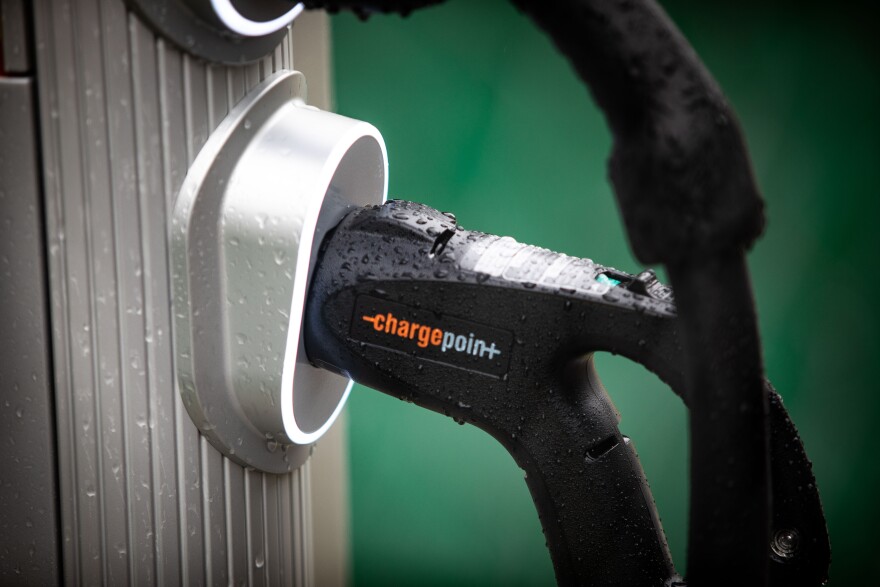As Texas gasoline prices hit their highest level in seven years and the appeal of electric vehicles reaches a wider range of drivers, the public and private sectors are racing to build networks of EV charging stations. And they're looking to Washington where a bipartisan infrastructure deal could add 500,000 charging stations across the U.S. by 2030.
The number of charging stations "has been keeping pace with the number of new vehicles being sold generally speaking," said Norman Hajjar, an executive with the EV data company PlugShare. But he warned of "pinch points" that could emerge if charging infrastructure fails to keep up with demand.
"We're going to see a huge mushroom of new electric vehicles in the next 10 years, so there's where the rubber needs to meet the road," Hajjar said.
The Austin-area has almost 700 electric vehicle charging locations right now, according to PlugShare. Almost all locations have multiple charging stations.

Gabriel C. Pérez/KUT
Austin Energy operates 300 of those charging locations — a total of 1,200 charging stations overall — and the publicly owned utility is adding about 200 more charging stations per year. ChargePoint, which runs the nation's largest network of charging stations, is working to add charging infrastructure to more than 4,000 travel plazas and fuel stops in rural communities nationwide by the end of the decade.
By that time, electric vehicles will make up 29% of all vehicles sold, according to estimates by the energy research provider BloombergNEF.
Americans are being increasingly drawn to electric vehicles as automakers widen their offerings at a range of price points and consumers learn about the improved driving experience: instant power and fast acceleration, a smoother ride, a quieter cabin and lower cost of ownership over the lifetime of the vehicle.
The 2021 Mini Cooper SE starts at $30,750 before a federal tax credit of $7,500. The 2021 Nissan Leaf comes to $32,620 before the same tax credit. Ford announced the base model of its all-electric F-150 Lightning will cost less than $40,000 when it goes on sale in early 2022.
"I think based on what the reach and capabilities of the Ford F-150 Lighting and the pricing, we could see another doubling of EV sales in Austin ... almost overnight," said Karl Popham, who manages electric vehicle infrastructure for Austin Energy. He said that hasn't happened since the release of the Tesla Model 3.
Austin Energy estimates there will be more than 52,000 EVs in Austin by 2023. Right now, over 15,000 plug-in hybrid and plug-in battery electric vehicles are registered in Travis and Williamson counties with another 300 added each month, according to Electric Power Research Institute data provided to Austin Energy. The public utility offers an EV buyer's guide that checks real-time inventory at local dealerships.
Details of a federal bipartisan infrastructure deal are still being worked out, but a framework of the agreement released by the White House includes $7.5 billion for electric vehicle infrastructure. That's enough, the White House says, to build 500,000 stations nationwide, 10 times the number that exist today.
But most electric vehicle charging happens at home. Austin Energy offers customers a 50% rebate on the cost of buying and installing a Level 2 charging station, which can refill a battery in a matter of hours. The rebate is capped at $1,200.
DC fast chargers, more commonly found at public charging stations, can refill a battery to 80% in as little as 15 minutes. Last year, Austin Energy added four DC fast chargers on a stretch of Second Street in the Seaholm District called Electric Drive. By the end of July, it'll have four more.

Gabriel C. P´erez/KUT
Lingering questions about EV charging infrastructure remain, like the strain it could place on electric grids during peak hours, especially in a state still recovering from an unprecedented blackout that left millions without power. Gov. Greg Abbott just called a special legislative session and left grid resiliency off the agenda.
But electric vehicles could actually help stabilize the grid, researchers say, if utilities could buy electricity from plugged-in vehicles when power generators are struggling to meet demand. A recent pilot project in the United Kingdom involving the Nissan Leaf found such "vehicle-to-grid" charging systems could reduce the need for power generation, cut carbon emissions and save vehicle owners money.
EVs might even save their owners' lives by serving as home backup batteries during extended power outages, according to a survey of electric vehicle research and pilot projects by Rocky Mountain Institute's Electricity Innovation Lab. Ford is promising such home backup power capability in its F-150 Lightning.
"A car with a 30 kWh battery stores as much electricity as the average U.S. residence consumes in a day," the Electricity Innovation Lab report said.
Interest in electric vehicles flares whenever gasoline prices spike. The Texas average for a gallon of regular hit a seven-year high this week, according to a survey of gas stations by AAA Texas. Rising oil prices signal more expensive gas is around the corner as people hit the road for summer vacation after more than a year spent hunkering from a killer virus wreaking havoc worldwide.
Correction: This story has been updated to show Electric Drive currently has four DC fast chargers, not eight. Another four will be installed by the end of July.
Got a tip? Email Nathan Bernier at nbernier@kut.org. Follow him on Twitter @KUTnathan.
If you found the reporting above valuable, please consider making a donation to support it. Your gift pays for everything you find on KUT.org. Thanks for donating today.
"electric" - Google News
July 10, 2021 at 02:12AM
https://ift.tt/3AOVHyg
As Electric Vehicles Grow In Popularity, So Does Austin's Need For Charging Stations - KUT
"electric" - Google News
https://ift.tt/2yk35WT
https://ift.tt/2YsSbsy
Bagikan Berita Ini














0 Response to "As Electric Vehicles Grow In Popularity, So Does Austin's Need For Charging Stations - KUT"
Post a Comment